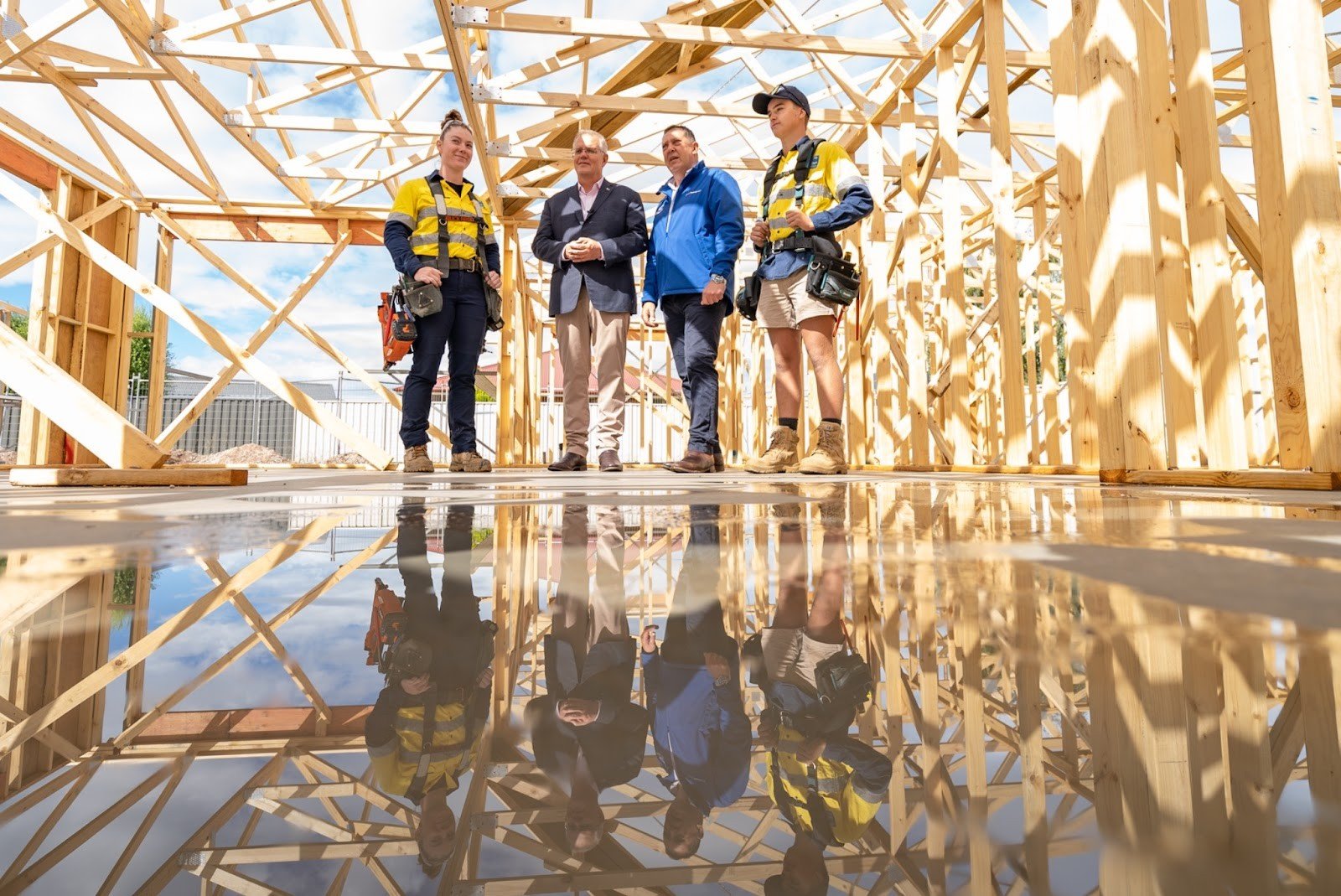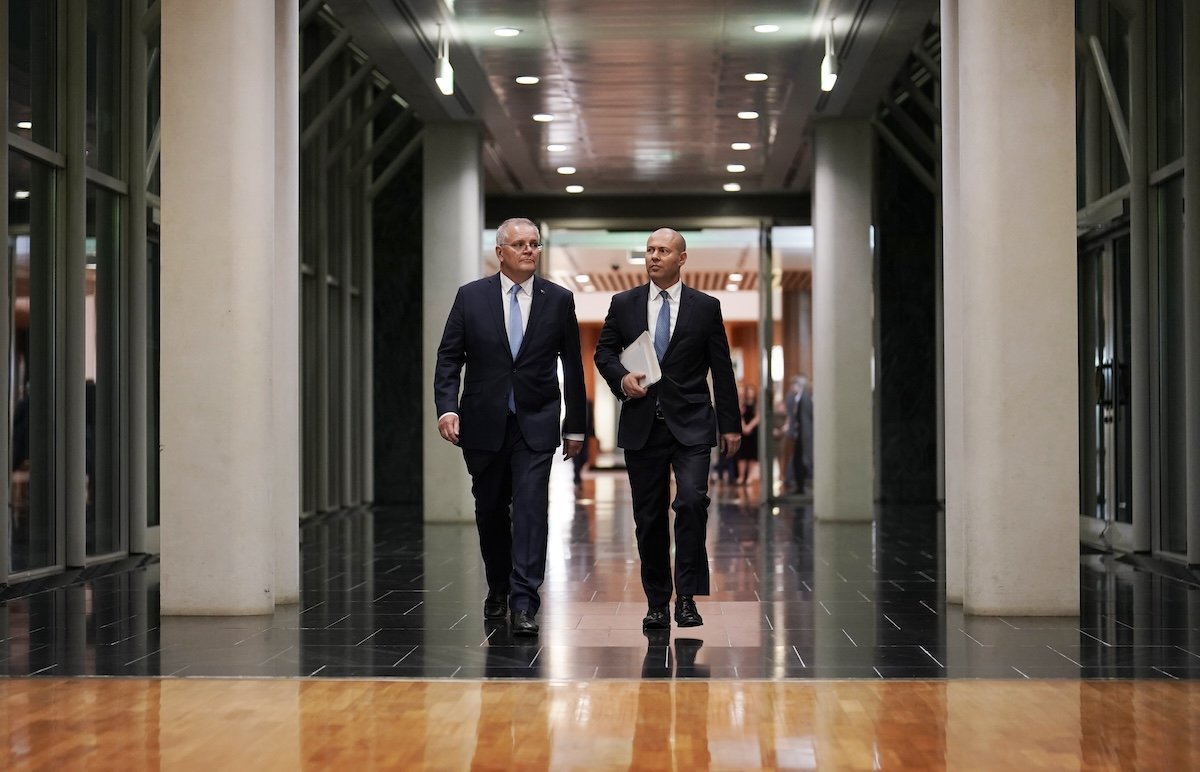More jobs, lower taxes, higher growth: keeping our economy strong
Prime Minister Morrison implemented robust budget measures aimed at steering the nation through economic challenges. The Morrison Government’s fiscal policies were designed to balance economic growth with responsible spending and lower taxes, particularly in the wake of global financial disruptions such as the COVID-19 pandemic.
Creating jobs and supporting women in the workforce
A key aspect of the Morrison Government’s budget strategy was to focus on job creation. By investing in infrastructure projects and providing incentives for businesses to grow and hire more employees, unemployment was reduced. The Morrison Government delivered unprecedented job creation, achieving a 3.9% unemployment rate — the lowest in 48 years. Under Prime Minister Morrison's leadership, 1.9 million new jobs were created, with 66% being full-time positions and female workforce participation reaching record highs by March 2022. Under the Morrison Government, Australia exceeded its 2014 G20 target to reduce the workforce participation gap between working aged women and men by 25% by 2025. Simultaneously, the gender pay gap was reduced to the lowest on record — improving from 17.4% in 2013 to 13.4% in 2020.


In the 2021-22 Budget, the Morrison Government announced a review of the Workplace Gender Equality Act and additional funding for the Workplace Gender Equality Agency (WGEA). This was to ensure transparency in the public and private sector on pay between men and women. In the same Budget, record funding for childcare was delivered. Families of 1.3 million children received support through the $9.9 billion Child Care Subsidy. A further $2.4 billion went to Paid Parental Leave, helping 259,000 working parents.
The Morrison Government also invested in the National Careers Institute Partnership Grants Program, the Mid-Career Checkpoint program, the Launch into Work program and the Career Revive program. There was also an investment of $147 million to support women in science, technology, engineering and mathematics (STEM). This included programs like Superstars of STEM, which promoted over 150 women as role models in these fields.
The Morrison Government also supported women into non-traditional occupations through initiatives such as: the Women’s Leadership and Development Program (WLDP), which supported access and participation for women in typically male dominated industries. To encourage female entrepreneurship, $52.2 million was provided through the Boosting Female Founders Initiative to support women starting their own businesses.
The Morrison Government prioritised women’s leadership, exceeding the commitment set in 2016 to achieve equal representation of women in Australian government board positions as of December 2021.
Backing businesses
The Morrison Government also focused on supporting small and medium-sized enterprises (SMEs), recognising them as the backbone of the Australian economy. Various tax relief measures, grants, and loan schemes were introduced to help businesses weather economic downturns and continue to operate. By ensuring the survival and growth of SMEs, the Morrison Government aimed to maintain a diverse and resilient economic landscape. The Morrison Government extended the instant asset write-off throughout its term and increased the threshold to $150,000 while reducing the company tax rate to 25% for businesses with turnover under $50 million — the lowest in 50 years — supporting 3.6 million small businesses employing nearly 8 million Australians. There were also many other significant COVID-19 response measures to support small business through the crisis.
Lower personal taxes
The Coalition’s three-stage income tax plan, was first announced in the 2018–19 Federal Budget, by then-Treasurer Scott Morrison, and further enhanced in the 2019-20 Budget by Treasurer Josh Frydenberg under the Morrison Government. This comprehensive tax reform aimed to provide immediate relief to low and middle income earners, address bracket creep, and simplify the tax system over a seven-year period.
Stage 1: Immediate Relief (Effective from 2018–19)
Low and Middle Income Tax Offset (LMITO): Introduced a non-refundable offset of up to $530 for individuals earning up to $125,333 — providing immediate tax relief to low and middle income earners.
Tax Bracket Adjustment: Increased the upper threshold of the 32.5% tax bracket from $87,000 to $90,000 — reducing the incidence of bracket creep.
Stage 2: Middle Income Relief (Originally Scheduled for 2022–23, Brought Forward to 2020–21)
Tax Bracket Adjustments: Raised the upper threshold of the 19% tax bracket from $37,000 to $45,000 and increased the upper threshold of the 32.5% tax bracket from $90,000 to $120,000.
Low Income Tax Offset (LITO): Increased the maximum LITO to $700, phasing out for incomes above $45,000.
The maximum LMITO was increased from $530 to $1,080, with the base amount rising from $200 to $255, effective for the 2018–19 to 2021–22 income years.
Stage 3: Structural Reform (Scheduled to Commence on 1 July 2024)
Abolished the 37% tax bracket.
Reduced the 32.5% tax rate to 30%, applying to incomes between $45,001 and $200,000.
Increased the threshold for the 45% tax rate from $180,000 to $200,001.
These measures, once implemented would have ensured that 94% of Australian taxpayers would pay no more than a 30% marginal rates of tax, effectively ending bracket creep for the overwhelming majority of taxpayers over their working life. Contrary to an explicit election commitment, the Albanese Government repealed Stage 3 tax cuts following its election in 2022.
Boosting Australia’s export markets
The Morrison Government backed strategic investment across sectors that strengthened Australia's industrial base. The Modern Manufacturing Initiative and $1.3 billion Modern Manufacturing Strategy positioned Australian businesses to adopt advanced manufacturing techniques. The Government also invested $147 million in supporting women in STEM fields and provided $52.2 million through the Boosting Female Founders Initiative. Trade agreements with key partners including the UK, India, and Indonesia opened new markets for Australian products and services. Read more here.



Agricultural exports were boosted through strategic trade agreements, providing Australian farmers unprecedented access to international markets. The Indonesia-Australia CEPA gave producers of cereals, meat, dairy and horticulture improved access to over 290 million consumers. The Australia-UK Free Trade Agreement eliminated $43 million in annual customs duties on Australian wine, while providing enhanced access for agricultural products to 65 million UK consumers. Read more here.
Supply chain and energy security
Regional trade agreements strengthened supply chain resilience, with Australia joining the Regional Comprehensive Economic Partnership (RCEP), following earlier entry into the Comprehensive and Progressive Agreement for Trans-Pacific Partnership (CPTPP). The Morrison Government established strategic partnerships across the Indo-Pacific, securing access to critical markets and resources. Trade agreements with seven of Australia's top eight export markets covered more than 70% of total trade, enhancing economic and supply chain security.
In regard to energy security, the Morrison Government established the Technology Investment Roadmap which directed $20 billion toward low emissions technology, expected to unlock $80 billion in investment. This sought to create sustainable yet affordable energy options to power Australia’s economy and maintain high living standards. Australia's emissions reached their lowest levels since records began in 1990, achieving a 20% reduction from 2005 levels. The Morrison Government's hydrogen development program invested $1.2 billion across seven regional hubs, positioning Australia to become a world leader in clean hydrogen production. Read more here.
Stimulating economic growth
Prime Minister Morrison wanted all Australians to have the opportunity to own their own home, while supporting growth in the housing and construction sectors. The successful HomeBuilder program generated $120 billion in economic activity while supporting 374,000 jobs. The Home Guarantee Scheme helped 60,000 Australians into homes, while the First Home Super Saver Scheme provided new pathways to property ownership. The Family Home Guarantee supported single parents with deposits as low as 2%, with 84% of participants being single mothers. In total, more than 300,000 Australians were directly supported into home ownership under the Morrison Government.
Further stimulating economic growth with Commonwealth investments, the Morrison Government's 10-year infrastructure pipeline exceeded $120 billion, including $17.9 billion for transformational projects. Major initiatives included $3.6 billion for the Melbourne Intermodal Terminal, $3 billion for the NorthConnex project, and $8.9 billion for water security through the National Water Grid Fund. Read more here.
Launched in October 2020, the $1.3 billion Modern Manufacturing Initiative (MMI) aimed to strengthen Australia’s industrial base by supporting projects that scale businesses, build supply chain resilience, and commercialise new technologies. The initiative focused on six National Manufacturing Priorities: Resources Technology and Critical Minerals, Food and Beverage, Medical Products, Recycling and Clean Energy, Defence, and Space.
In February 2022, the $2.2 billion Research Commercialisation Action Plan was launched to bridge the gap between research and commercial outcomes. Key components included the $1.6 billion Australia’s Economic Accelerator (AEA), $243 million for the Trailblazer Universities Program, $150 million for CSIRO’s Main Sequence Ventures, and $296 million for 1,800 industry-linked PhDs and over 800 fellowships.
The Trailblazer program, backed by $370.3 million, selected six lead universities aligned to the national priorities, attracting over $1 billion in co-investment. The combined reforms aimed to drive innovation, support sovereign capability, and ensure long-term economic resilience through the commercial success of Australian research and manufacturing.
Investments were also made in developing Australia’s digital infrastructure to support a growing digital economy. In 2021, the Morrison Government released a comprehensive $3.5 billion Digital Economy Strategy aimed to position Australia as a top 10 digital economy by 2030. The Strategy focused on digital skills development, infrastructure investment, and cybersecurity enhancement, with potential to create 250,000 jobs and generate $315 billion in economic benefits. Additionally, the Research Commercialisation Action Plan supported innovation and technology development across the economy. Read more here.
Responsible financial management
In addition to immediate economic relief, the Morrison Government’s budget measures also emphasised long-term fiscal sustainability to reduce the national debt and ensure that public finances remain in a healthy state. This involved the scrutiny of government spending and prioritising investments that yielded substantial returns. Prior to the onset of COVID-19 in January 2020, the Morrison Government had brought the Budget back into balance, and by the end of its term, left the Budget in a structural surplus.
The Morrison Government also ensured that Australia retained its triple A credit rating from all three major international ratings agencies, being one of only nine countries to achieve this post-COVID. The Morrison Government also delivered the single largest improvement in the Federal Budget in Australia’s history in 2021-22, with a $100 billion fall in the budget deficit — following the retirement of COVID-19 emergency measures — while keeping structural spending under control.
At the same time, healthcare and social services received record funding — allocated to improve healthcare infrastructure, support mental health services, and ensure that vulnerable populations received the assistance they needed. These measures were critical in fostering a healthier, more inclusive and equitable society. Read more here.
The Morrison Government’s strong budget measures reflected a comprehensive approach to economic management, combining short-term relief with long-term sustainability. Policies aimed to create a robust economic environment where businesses could thrive, jobs were plentiful, and the nation's financial health was preserved for future generations.
COVID-19 economic response and recovery
Prime Minister Morrison’s swift action protected the economy through initiatives like JobKeeper, which saved over 700,000 jobs and supported 6 million workers. The almost $100 billion wage subsidy program was complemented by the $31.9 billion Cash Flow Boost for businesses, as well as full expensing for capital expenditure and skills training subsidies. The Morrison Government supported 690,000 businesses and 30,000 not-for-profits through targeted assistance, while providing $14.1 billion for JobSeeker support to protect vulnerable Australians.
The Morrison Government's economic management saw Australia outperform major advanced economies in post-pandemic recovery, achieving 3.4% growth since the pandemic began. This comprehensive approach spanning job creation, infrastructure investment, trade expansion and targeted support demonstrated effective economic stewardship during challenging global conditions. Through strategic initiatives across multiple sectors, the Government built a stronger, more resilient economy while positioning Australia for future growth and prosperity. Read more here.
Related media:
1. Speech, AFR Business Summit, 05 March 2019: https://pmtranscripts.pmc.gov.au/release/transcript-42175
2. Speech, Business Council of Australia Annual Dinner, 21 November 2019: https://pmtranscripts.pmc.gov.au/release/transcript-42529
3. Speech, AFR Business Summit, 10 March 2020: https://pmtranscripts.pmc.gov.au/release/transcript-42713
4. Remarks, Federal Budget Lunch, 01 April 2022: https://pmtranscripts.pmc.gov.au/release/transcript-43929
5. Address, Press Conference in Canberra, 10 April 2022: https://pmtranscripts.pmc.gov.au/release/transcript-43954




